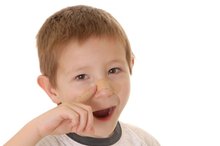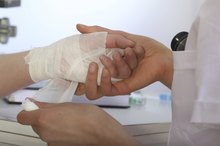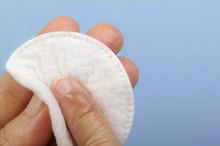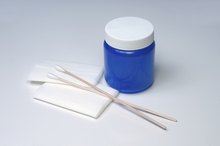Can You Swim in a Pool With a Burn Blister?
Nothing can ruin a summer faster than a child who can't go swimming because of an injury. Burn blisters are one such injury. They are blisters that form on burned skin so the body can protect and heal itself. Because of the sensitivity of burn blisters, the child should stay out of the pool, at least for the initial healing period.
If you are experiencing serious medical symptoms, seek emergency treatment immediately.
About Burn Blisters
Burn blisters are caused by scalds, contact with hot objects or flames, chemical burns or electrical burns 1. The severity of the burn predicts whether there will be a blister. Burns fall into one of three categories--first, second or third degree 1. First-degree are minor, and third-degree are the most severe. Second-degree burns mean the skin beneath the top layer is burned, causing blisters, redness and severe pain 1. The blisters contain a fluid called serum. It's watery and leaks from blood vessels and tissues that have been destroyed. If the blister breaks open, the skin looks moist with a pink or red color.
- Burn blisters are caused by scalds, contact with hot objects or flames, chemical burns or electrical burns 1.
- It's watery and leaks from blood vessels and tissues that have been destroyed.
Healing Time
How to Treat a Burn Bubble
Learn More
It can take three weeks or more for second-degree burns to heal 1. Leave the blister intact as it heals because the body will absorb the fluid, the skin will drop off and new skin will emerge. The area remains sensitive until completely healed. Swimming is not a good idea until the burn blister has healed sufficiently and new skin is in place across the wound. Chlorine is harsh and can irritate the skin and make it sting. Avoid pools at all costs if your burn is still raw and weeping fluid. If it's a small wound, lather on antibiotic cream and cover with a gauze pad or bandage before swimming.
- It can take three weeks or more for second-degree burns to heal 1.
- Leave the blister intact as it heals because the body will absorb the fluid, the skin will drop off and new skin will emerge.
About Chlorine
Chlorine, a strong chemical that sanitizes pool water, can cause red, itchy, sore eyes or skin, depending on sensitivity. Any condition that weakens the skin such as burn blisters will be further irritated by chlorine. Burn blisters that are oozing blood or fluid will infect the water and can become further infected by bacteria in the water.
Treatment
Uses of Antiseptic Cream
Learn More
With the use of antibiotic cream and gauze, the burn blister will dry up in about 10 days. Afterward, use Bacitricin or other ointment to keep the skin supple and protect it as it heals. Check the blister daily to ensure it's not becoming infected. Signs of infection include pus, pain, redness and swelling. See a doctor if you notice these signs.
- With the use of antibiotic cream and gauze, the burn blister will dry up in about 10 days.
- Afterward, use Bacitricin or other ointment to keep the skin supple and protect it as it heals.
Related Articles
References
- Kids Health: Burns
- Hilton G. Thermal Burns: The ABCs are crucial, since the major threat is often inhalation injury. Am J Nurs. 2001;101(11):32-34. doi:10.1097/00000446-200111000-00017
- Cleveland Clinic. Burns. Updated August 31, 2017.
- Thom D. Appraising current methods for preclinical calculation of burn size - A pre-hospital perspective. Burns. 2017;43(1):127-136. doi: 10.1016/j.burns.2016.07.003.
- Knowlin, L., Stanford, L., Moore, D., Cairns, B., & Charles, A. (2016). The Measured Effect Magnitude of Co-Morbidities on Burn injury Mortality. Burns : Journal of the International Society for Burn Injuries, 42(7), 1433–1438. http://doi.org/10.1016/j.burns.2016.03.007
Writer Bio
Based in New York State, Kelly Shetsky started writing in 1999. She is a broadcast journalist-turned Director of Marketing and Public Relations and has experience researching, writing, producing and reporting. She writes for several websites, specializing in gardening, medical, health and fitness, entertainment and travel. Shetsky has a Bachelor of Arts in communications from Marist College.








